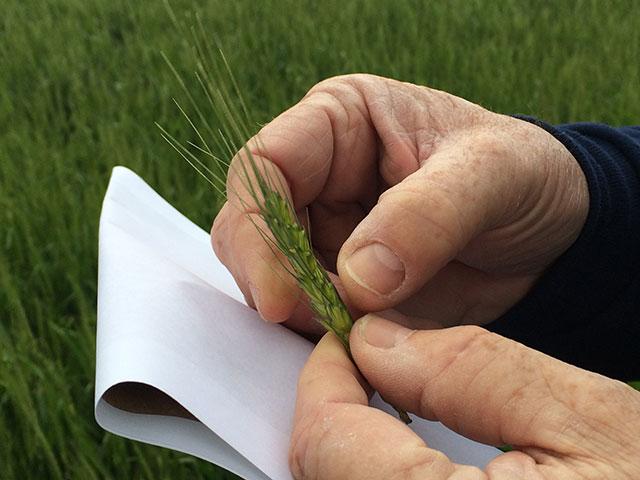Wheat Tour to Examine Toll of Drought
One Question for 2023 Winter Wheat Tour: How Bad Is It?
STEAMBOAT SPRINGS, Colo. (DTN) -- The rain finally came, washing across the state of Kansas early this week, more than 2 inches in spots from Wichita to Manhattan and more than 3 in at least one spot to the west, Larned. There were even flood warnings in the northwest corner of the state, something few farmers in the area could complain about in what's been a dry spring in a dry year in a dry, well, decade.
"I thought my eyes were deceiving me," said Aaron Harries, vice president of research and operations with the Kansas Wheat Commission, seeing the rain fall.
Unfortunately for the state's signature commodity, hard red winter wheat, analysts don't expect the May showers to do much to save this year's crop, and this week as the annual Wheat Quality Council Hard Winter Wheat tour sets off to scour the state, the focus will likely be centered on "just how bad is it?"
The answer could be "pretty darn," the kind of bad that makes experts dive deep into the archives to find anything comparable.
"The big question is: Will the crop be under 200,000,000 bushels or over?" Harries said. "The harvest in Kansas hasn't been below 200,000,000 since 1963."
That's 1963, as in John F. Kennedy is president, Martin Luther King, Jr., has a dream and "The Beatles? Aren't they just kind of a British thing?" 1963.
The expectation is that the current drought, part of a third consecutive year of dryness, has wrought havoc on this year's Kansas hard red winter wheat crop, typically the nation's largest supply of the grain.
Harries has identified 1996 as the last comparable measuring stick. That year's crop suffered from late freezes more than dry weather, and in the end, 25.4% of the planted crop was abandoned.
It was worse in 1989, when 28% of acres never made it to harvest. Last year it was 9.6% while the average year is closer to 5%.
P[L1] D[0x0] M[300x250] OOP[F] ADUNIT[] T[]
How will 2023 stack up?
"That's the big story," Harries said. "A lot of the wheat won't be harvested."
Indeed, the recent rains have likely come too late, as much of the crop has already headed. The exception may be in the northwestern corner of the state, where the wheat is late enough to potentially benefit, but that's one of few areas looking even average.
"The northwest corner may have a chance, and there are two or three counties in central Kansas that may do close to normal, but the big region is the eastern two-thirds of Kansas, and the bulk of that is in really tough shape," DTN Lead Analyst Todd Hultman said.
Recent USDA reports are equally pessimistic. A May 7 report on the crop conditions in Kansas rated only 1% of the state as excellent and 10% good. A total of 68% was slated as poor (31%) or very poor (37%).
Oklahoma was labeled with similar numbers, 64% falling under very poor and poor, while Nebraska was only slightly better with 51% falling in those two divisions.
Friday's WASDE report joined the chorus in predicting a bad harvest, forecasting reduced U.S. wheat supplies despite a modest increase in total bushels nationally. The predicted national average yield, 44.7 bushels, is down 1.8 from 2022.
In Kansas, last year's crop -- below average but not as direly so as this year's -- averaged 37 bushels to the acre across the state, producing 244,200,000 bushels. This year's is estimated to be worse, 191,400,000, according to USDA figures on Friday, officially putting that 1963 record on notice.
"The situation in Kansas and the Oklahoma panhandle looks worse than last year by just about every metric," Hultman said. "The vegetative index, moisture, even the rain forecast looking ahead, it doesn't look as good as it did even last year, and last year was pretty bad."
There are plenty of people interested in finding out the details. This year's wheat tour has a record number of registrants, 105, about 20 more than a year ago and 30 or 40 more than average, according to Dave Green, the tour organizer. The tour will consist of university crop researchers, agronomists, journalists and representatives from seed companies, millers and food manufacturers, among others.
"There's just a general increase in interest this year," Green said. "A lot of the big companies want to have people on the ground and not just hear about it from someone else. People want to see this crop."
Those on the tour will have some unique challenges.
Typically, Green said, tour members spread out into a field and try to formulate a yield estimation on their own. When they get back together in the car, they happily realize most of their data is consistent.
Things could be different in 2023.
"This year, it won't be uniform. The fields will be patchy. They'll be wavy. The top of the hills will be worse than the valleys, and that tends to complicate the job everyone's trying to do," Green said.
This year's tour starts Monday, May 15, in Manhattan where the group will be trained to compute wheat yield potential and look for everything from evidence of disease to freeze damage. From there, the group heads out along six predetermined paths, stopping at randomly selected fields spaced 15 to 20 miles apart. The tour reconvenes in western Kansas, in Colby, on Tuesday night, then again in Wichita on Wednesday before returning to Manhattan to reveal and review the final yield prediction and crop estimates.
DTN will be on the tour this year and reporting from the road. Check in to www.dtnpf.com for updates including yield estimates, nightly.
Joel Reichenberger can be reached at Joel.Reichenberger@dtn.com
Follow him on Twitter @JReichPF
(c) Copyright 2023 DTN, LLC. All rights reserved.






